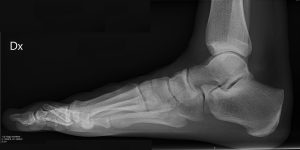
Here are 22 of the most common foot X-ray measurements:
- Medial malleolar distance: The distance between the medial malleolus (inside ankle bone) and the center of the talus to assess ankle joint stability.
- Lateral malleolar distance: The distance between the lateral malleolus (outside ankle bone) and the center of the talus to assess ankle joint stability.
- Talar declination angle: The angle between the talar dome (top of the ankle bone) and a horizontal line to assess the vertical alignment of the talus.
- Talar-first metatarsal angle: The angle between the long axis of the talus and the long axis of the first metatarsal to assess forefoot and midfoot alignment.
- Calcaneal inclination angle: The angle between the calcaneal axis (line from the top of the calcaneus to the bottom) and a line perpendicular to the floor to assess hindfoot alignment.
- Talocalcaneal angle: The angle formed between the line bisecting the talus and the calcaneus to assess hindfoot alignment.
- Tibiotalar angle: The angle formed between the tibial axis (line from the top to the bottom of the tibia) and the talus to assess ankle joint alignment.
- Anterior tibial translation: The distance between the tibial plafond (top of the tibia) and the anterior edge of the talus to assess anterior ankle instability.
- Talar tilt angle: The angle between the talar neck (narrow part of the ankle bone) and a line perpendicular to the floor to assess ankle joint instability.
- First metatarsophalangeal joint angle: The angle between the first metatarsal and the proximal phalanx of the big toe to assess hallux valgus deformity.
- Intermetatarsal angle: The angle between the first and second metatarsals to assess hallux valgus deformity.
- Hallux interphalangeal angle: The angle between the proximal and distal phalanges of the big toe to assess hallux rigidus deformity.
- Calcaneal pitch angle: The angle between the calcaneal axis and a line perpendicular to the floor to assess hindfoot alignment.
- Arch angle: The angle between the navicular bone and the first metatarsal to assess foot arch height.
- Naviculocuneiform angle: The angle formed between the navicular bone and the medial cuneiform bone to assess forefoot alignment.
- Meary’s angle: The angle formed between the first metatarsal and the talus to assess forefoot alignment.
- Metatarsal protrusion distance: The distance between the longitudinal axis of the first metatarsal and the second metatarsal to assess forefoot alignment.
- First metatarsal declination angle: The angle formed between the first metatarsal and the ground to assess forefoot alignment.
- Sesamoid position: The position of the sesamoid bones (small bones under the big toe joint) to assess hallux valgus deformity.
- Distal metatarsal articular angle: The angle between the first metatarsal shaft and the articular surface of the head of the metatarsal to assess hallux rigidus deformity.
- Proximal phalanx articular angle: The angle between the proximal phalanx of the big toe and the metatarsal head to assess hallux valgus deformity.
- Metatarsal parabola angle: The angle formed between the longitudinal axis of the first metatarsal
